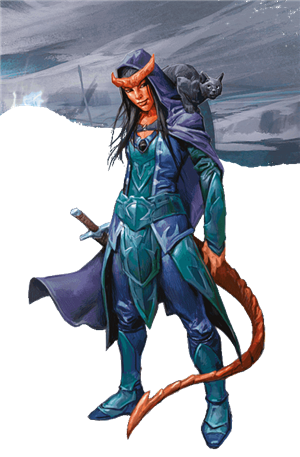 The shadows of the night need not be a power reserved for evil sorcerers and sinister specters. Like the arcane tradition of Necromancy or the monastic Way of the Shadow before it, the Shadow Magic sorcerous origin allows sorcerers a way to commune with the darkness and use its power for their own purposes—for good or for ill. Following the path of a shadow sorcerer is an excellent character choice for characters who straddle the line between good and evil, or for characters whose intentions are good but who are susceptible to temptation by dark powers.
The shadows of the night need not be a power reserved for evil sorcerers and sinister specters. Like the arcane tradition of Necromancy or the monastic Way of the Shadow before it, the Shadow Magic sorcerous origin allows sorcerers a way to commune with the darkness and use its power for their own purposes—for good or for ill. Following the path of a shadow sorcerer is an excellent character choice for characters who straddle the line between good and evil, or for characters whose intentions are good but who are susceptible to temptation by dark powers.
Emulating Shadow Sorcerers from Fiction
Shadow sorcerers are well-suited to fulfilling a couple of different character archetypes, many of which are well suited for a Halloween game of D&D. Even though their power source casts them as a gothic, perhaps even morbid character, shadow sorcerers truly can hail from all alignments. It’s easy to go dark and edgy with a shadow sorcerer, but finding a way to play an idealistic, even heroic character using this archetype can be incredibly rewarding. Raven from Teen Titans presents a heroic look at the shadow sorcerer; even though her demeanor is gloomy and she wields dark magic gained from her mysterious past, Raven is a hero at heart, and she uses her dark powers for good. The dichotomy between her tutors in the ways of magic—the monks of Azarath—and the primordial source of her power—the devil Trigon—makes for compelling character drama.
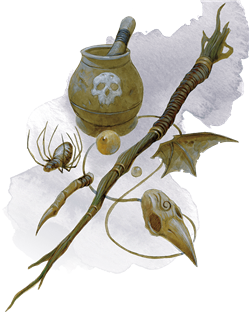 The shadow sorcerer can even work in a more lighthearted campaign, akin to the mundane familiarity with the morbid present in characters like Gomez or Morticia Addams—but possessing great magical power. Playing a character who loves grim and gothic things the way “normal” people like bright and sunny things is always good for a laugh, and playing a shadow sorcerer is a great way to connect your funny character choice to a legitimately powerful set of class features.
The shadow sorcerer can even work in a more lighthearted campaign, akin to the mundane familiarity with the morbid present in characters like Gomez or Morticia Addams—but possessing great magical power. Playing a character who loves grim and gothic things the way “normal” people like bright and sunny things is always good for a laugh, and playing a shadow sorcerer is a great way to connect your funny character choice to a legitimately powerful set of class features.
As a heroic shadow sorcerer in a party of adventurers, you can show the other characters that evil is not a facet of one’s birth. Even though you were born with a spark of shadow within you, that power does not define you: what truly matters is what you choose to do with that power. That you choose to do good differentiates you from villains like Strahd or Manshoon, even though your magic may resemble theirs. They, and other monsters like them, embraced evil willingly. Your character’s presence in a campaign could deepen the story’s moral complexity, allowing you to really dig into the drama of a D&D game, if that’s your preference.
The Source of Your Power
The source of a sorcerer’s magic is a compelling mystery that can create the framework for a dozen different character concepts. As a shadow sorcerer, your magical power “comes from the Shadowfell itself.” According to Xanathar’s Guide to Everything, “You might trace your lineage to an entity from that place, or perhaps you were exposed to its fell energy and transformed by it.” The Shadowfell is a great source for your magic; your power source might be the plane itself, or it might be any number of mighty beings that dwell within it.
If you want to entwine your character’s history with the plot of your campaign, you should talk with your DM about it! Ask yourself some questions first, and maybe even be willing to answer these questions with your DM. Is the source of your power a person, or the plane itself? Does your character know who or what the source of your power is? Do you know what the source of your character’s power is, or do you want to leave it up to the DM to decide so it can be a mystery you solve during the campaign? Do you want the source of your power to be a villain (like Trigon in Teen Titans) or a more impassive, cosmic source like the Raven Queen?
If you don’t want to overplan your character, you can also keep these questions in mind during play, and improvise a backstory while playing.
Playing a Shadow Sorcerer
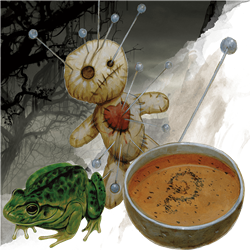 Let’s take a close look at the magic you wield by virtue of being a Shadow Magic sorcerer. You have access to the same list of spells as every other sorcerer, but you also have a collection of class features that set you apart from the rest.
Let’s take a close look at the magic you wield by virtue of being a Shadow Magic sorcerer. You have access to the same list of spells as every other sorcerer, but you also have a collection of class features that set you apart from the rest.
The first thing you should consider is a quirk. This isn’t a hard-coded mechanical class feature, but choosing one of the gothic quirks presented in Xanathar’s Guide to Everything could help make your character just a little weirder and more supernatural.
At 1st level, you gain Eyes of the Dark, which grants you 120 feet of darkvision. This makes you a good explorer, but it also makes you a stealthier character, since you can sneak through the dark without a light source to give you away. At 3rd level, you automatically learn the darkness spell, and your Eyes of the Dark let you see through magical darkness that you create. Other sources of magical darkness are still impenetrable to you.
Also at 1st level, your Strength of the Grave feature lets you make a Charisma saving throw to avoid being reduced to 1 hit point. It’s a slightly less reliable version of the half-orc’s Relentless Endurance trait. This class feature is interesting, because it’s most useful when you get right into the thick of combat. It can sometimes be useful when remaining in the back lines, but it synergizes well with spells like shadow blade that encourage you to get close to the enemy and risk taking a few hits.
Your 6th-level feature, Hound of Ill Omen, grants you a temporary, weaponized animal companion. Inspired by other shadow hounds throughout literature and mythology, like the many incarnations of the black dog of British folklore. Instead of being a permanent addition to your party like a Beast Master’s animal companion, your Hound of Ill Omen allows you to designate a creature you wish to kill, and then create a shadow hound that pursues and attacks it until its time runs out, the target dies, or the hound is destroyed. It can also impose disadvantage on the target’s saving throws made to resist your spells, so it is an excellent tool to use against strong single monsters.
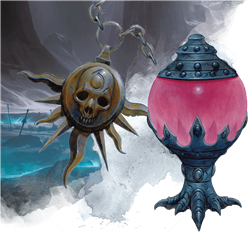 Since it costs 3 sorcery points to create the hound, it can’t be used in every circumstance. It’s probably more powerful to spend your points on Twinned Spell when facing groups of creatures, but don’t sleep on this feature. It’ll make boss monsters and other solo encounters quake in their boots.
Since it costs 3 sorcery points to create the hound, it can’t be used in every circumstance. It’s probably more powerful to spend your points on Twinned Spell when facing groups of creatures, but don’t sleep on this feature. It’ll make boss monsters and other solo encounters quake in their boots.
Shadow Walk, your 14th-level feature, is a classic shadow magic ability. It allows you to teleport from one pool of shadow to another as a bonus action, so long as they’re within 120 feet of one another. It’s very similar to the Way of Shadow monk’s Shadow Step feature, but its impressive 120-foot range really sets it apart. I can imagine some cute mentor/student interplay between a shadow monk and a shadow sorcerer, in which one teaches the other a move, with one putting their own unique spin on it.
Your 18th-level feature, Umbral Form, transforms you into an avatar of pure shadow. It’s very anime, in the best way. Or like a modern superhero movie, actually. Six sorcery points isn’t even a terribly steep price to pay at 18th level for a full minute of resistance to all damage and incorporeal movement. This is another feature that encourages a more in-your-face style of fighting by granting you additional defensive abilities. It’s a very different way of playing sorcerer than just sitting in the back rank and spamming ranged spell attacks, and that could be a great way to shake things up if you’re getting bored with playing spellcasters the same way all the time.
Playing a Shadow Sorcerer Your Way
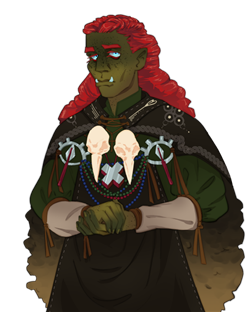 How will you play a Shadow Magic sorcerer this Halloween? There’s a lot of pressure from the class’s design to play the shadow sorcerer like a grim mortician, but that’s not the only way to play. In Encounter Roleplay’s Sands of Zehir stream, I played a character named Qual the Black Rose. He was a relentlessly cheery and optimistic shadow sorcerer, and the tension between his sunny demeanor and his dark magic made him a very fun character to play.
How will you play a Shadow Magic sorcerer this Halloween? There’s a lot of pressure from the class’s design to play the shadow sorcerer like a grim mortician, but that’s not the only way to play. In Encounter Roleplay’s Sands of Zehir stream, I played a character named Qual the Black Rose. He was a relentlessly cheery and optimistic shadow sorcerer, and the tension between his sunny demeanor and his dark magic made him a very fun character to play.
Shadow sorcerers also make me think of Aserannon, the half-orc cleric of the God of the Dead in my own D&D series, Worlds Apart. Her dour and devoted demeanor belies an astoundingly tender and caring heart, and your shadow sorcerer may be the same way. With such a thematic subclass at your disposal, you can afford to really go big with your character concept. Don’t be afraid to go all out this Halloween!
Art by Cat Lu (@cxinlu), used with permission.
 James Haeck is the lead writer for D&D Beyond, the co-author of Waterdeep: Dragon Heist and the Critical Role Tal'Dorei Campaign Setting, the DM of Worlds Apart, and a freelance writer for Wizards of the Coast, the D&D Adventurers League, and Kobold Press. He lives in Seattle, Washington with his partner Hannah and his kittens of ill omen, Mei and Marzipan. You can usually find him wasting time on Twitter at @jamesjhaeck.
James Haeck is the lead writer for D&D Beyond, the co-author of Waterdeep: Dragon Heist and the Critical Role Tal'Dorei Campaign Setting, the DM of Worlds Apart, and a freelance writer for Wizards of the Coast, the D&D Adventurers League, and Kobold Press. He lives in Seattle, Washington with his partner Hannah and his kittens of ill omen, Mei and Marzipan. You can usually find him wasting time on Twitter at @jamesjhaeck.








-
View User Profile
-
Send Message
Posted Oct 17, 2018I just started playing as a show magic sorcerer in a game of Dragon Heist. She’s a Human Waterdeep Noble who’s neutral good and wants to use her power and authority to improve things for the lower classes. She’s a daughter of the Noble house of Wand so her sorcery tend to clash with a lot of her family since most of them are Wizards and they resent how easy magic comes to her. And they are afraid of where her powers come from of course so it causes some tension.
Its been so fun playing as an optimistic character who uses really dark origins for her magic.
-
View User Profile
-
Send Message
Posted Oct 17, 2018OK, so Morticia's a Shadow Sorcerer, Gomez is a College of Swords Bard, Grandma's a Tome Warlock (Fey patron, think Baba Yaga, not Titania), Fester is... a Fighter (Brute or Champion) I guess, since he's mostly just unkillably tough, and the kids are are both Rogues, Mastermind or Inquisitive for Wednesday and Scout for Pugsley.
-
View User Profile
-
Send Message
Posted Oct 17, 2018I still hope taht one day I get a chance to play a fallen aasimar shadow magic sorcerer I keep picturing. That was Tainted by the Shadow fell already beeing born a fallen aasimar from that taint. A weirdo that seeks a way to become rather the first of a new vampire line ( no other vampires being part of the transformation) or a type of sorcerer lich...
-
View User Profile
-
Send Message
Posted Oct 17, 2018YES!
-
View User Profile
-
Send Message
Posted Oct 18, 2018Ultimate Halloween themed party. Shadow magic sorcerer, path of the zealot barbarian, death domain cleric, monster slayer ranger, and way of the long death monk. Also, pretty much any blood hunter archetype.
-
View User Profile
-
Send Message
Posted Oct 18, 2018I'm currently running a Shadar-Kai Shadow Sorceror, who is mildly touched in the head but has reasons behind his quirkiness, such as being afraid of objects that are associated with innocence since he takes people's bad memories for The Raven Queen and those are generally the worst ones.
I've had a lot of fun playing him and I've made my group laugh a few times at his weirder aspects, and I'm excited to explore his more gothic aspects as the campaign goes on.
-
View User Profile
-
Send Message
Posted Oct 18, 2018Really good write-up as always! Just a note tho: Umbral Form isn't resistant to all types of damage, it still takes the full amount of radiant and force damage
-
View User Profile
-
Send Message
Posted Oct 18, 2018Another good reference to go off of is Danny Phantom, if you've seen that show.
-
View User Profile
-
Send Message
Posted Oct 18, 2018Carol Lidell is the older sister of Alice Lidell from Godstow, England in the mid 19th century. After her sister fell through some portal, to what was referred to as "Wonderland" Carol, never believing her, bullied her miserably. There were all kinds of strange happenings in the area. One bright summer day, when Carol was about 10 years old, a strange mist rolled in and she ended up taking refuge in a small cave in the area. When she came out, she was stunned. She was no longer in England, she saw a landscape of blackened, broken stone. She had landed in the Shadowfell. She spent what she believes to be about 3 years there, but time works funny. She turned out to be incredibly lucky, surviving by the skin of her teeth, but the Shadowfell changed her in many ways. She has power now. One day, as she was running from a group of Shadar-Kai, more mists came in. She hid in another cave behind a large rock in a canyon. When she came out, she found herself in Faerun. Her time has twisted her. She appears almost dead, icy cold to the touch. There is a darkness within her now, she struggles to keep it in.
-
View User Profile
-
Send Message
Posted Oct 18, 2018Speaking of in-your-face spellcasters, Hexblade Warlock with Pact of the Blade is insanely fun, and is what I consider to be the perfect blend of martial and magic prowess. Nothing like hexing an opponent and then slicing them up with a magic Nodachi to liven up a session!
-
View User Profile
-
Send Message
Posted Oct 18, 2018Very nice! Love the comparison of Wonderland to the Feywild.
-
View User Profile
-
Send Message
Posted Oct 18, 2018Funny, Raven from Teen Titans was the first thing I imagined when hearing about this subclass.
Aside from Draconic Sorcerer, this feels like the most complete Sorcerer subclass. The capstone serves to cover the Sorcerer's biggest weakness, while the other skills compliment the magic well. Innate Darkvision also frees up race choice!
Good pairing with Hexblade Warlock's, too...perfect "Haunted One" backstory potential.
-
View User Profile
-
Send Message
Posted Oct 19, 2018my shadow sorcerer acts like a rogue lol carrying thieves tool and stuff
-
View User Profile
-
Send Message
Posted Oct 19, 2018Shadow sorcerer is good fun subclass shame the sorcerer class overall got buggered over this edition.
-
View User Profile
-
Send Message
Posted Oct 19, 2018Shadow Sorcerer that's scared of the dark. Enough said.
-
View User Profile
-
Send Message
Posted Oct 20, 2018I can't believe I missed Lurch. Though you could probably get away with using the statblock for a Flesh Golem, honestly.
-
View User Profile
-
Send Message
Posted Oct 20, 2018My shadow sorcerer Ridley is a black tabaxi, a teenage street urchin, with a fey warlock tiefling "sister" as the only person she really trusts. The two of them use their magic to be effective thieves and pickpockets. She doesn't know or care where her powers come from (I've left that to the DM to introduce as a plot element), but the nuns of the sun church orphanage sure didn't like them when they began to manifest in childhood. I try to play her like a sullen goth teen and an angry, cornered alley cat. My influences are Raven, young Selina Kyle from the Gotham TV series, and Negasonic Teenage Warhead. I only choose spells that I can flavour as shadowy. So there's gonna be a lot of illusion, fear, blindness. I get away with a bit of "black ice", "chill of the shadow" cold spells, some purple Sith lightning, just to have some damage dealers. And of course shadow blade. Shadow blade is brutal.
She is the best and I love herrrr
-
View User Profile
-
Send Message
Posted Oct 22, 2018I love my shadow sorcerer. He is a Charlatan, so he is always acting happy, excited, and obnoxiously "alive". It is only when he is either angry or on his last legs does his true nature really show, and at that point if you're not scared then you will be.
-
View User Profile
-
Send Message
Posted Oct 24, 2018I cracked a smile when I read, "In Encounter Roleplay’s Sands of Zehir stream, I played a character named Qual the Black Rose. He was a relentlessly cheery and optimistic shadow sorcerer, and the tension between his sunny demeanor and his dark magic made him a very fun character to play." -- I am playing my shadow sorcerer in a very similar way. He is an unfailingly optimistic halfling whose past (and sorcerous origin) are marked by real tragedy. He combats that by maintaining a perpetually sunny demeanor. I can't remember, but I think I was inspired by Matt Mercer's "Roleplaying Against Type" video -- super great lessons for everyone to keep in mind for fleshing out interesting characters.
And @Wolfcalibur1 --
I think you were being serious, and I think that is a very workable idea. Think about that superior darkvision and just how much more they could see about what is actually happening/lurking in the dark. Kind of like Riddick in Pitch Black--you know, except super scared of everything (like a sane, non-Furyan badass would be)
-
View User Profile
-
Send Message
Posted Oct 28, 2018I feel like this would be a great class to play as a drow!